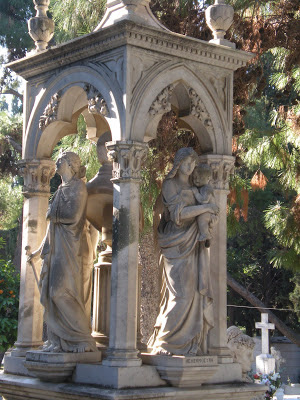Tinos, the Tinians, and the Cemetery
One legend has it that when
Phidias was exiled from Athens for skimping on the gold for Athena’s statue, he
left by a ship heading for Delos. But when a storm broke out, stranding him on
the small island of Tinos, he discovered its white and green marble, saw its potential,
and set about to teach the natives the art and secrets of sculpting.
The lessons must have gone well. From the 18th century and onwards,
Tinos had become the center of marble art
in the Greek world. Its artisans were in demand
everywhere: Constantinople, Romania, Odessa, Thessaloniki and Mount Athos. When
Greece finally freed itself from Ottoman rule, Tinos and its talented craftsmen
came into their own.
There was no
question that the emerging nation would establish a direct link between its new
national identity and that of ancient Greece. Marble was the perfect medium for that message.
As cosmopolitan and wealthy Greeks from the diaspora flocked
to Athens and bought property in the center of the city, there was a demand for
new and beautiful mansions for themselves and for civic buildings befitting the new
capital. Who would embellish these
facades, carve the intricate details, put the finishing touches on ceilings,
fireplaces, windows and columns? Who better than the Tinians? Working marble was already second nature to
them.
It helped
that the
Greek Royal family supported these talented artists with scholarships, in the
belief that their work would bring fame and recognition to Greece. In 1847, King Othon appointed the Bavarian Professor,
Christian H. Siegel to teach sculpting in the newly founded School of Arts in Athens. When he took
up his post, he was astounded that the majority of his students were from the
island of Tinos.
These youngsters had grown up working in their
families’ workshops and were already skilled
in the rudiments of the art. What was new was the -school’s emphasis on
three dimensional statuary, a branch of the arts which had not been encouraged in
the Ottoman empire, nor in earlier Byzantine ecclesiastical architecture either
for that matter. In short order these talented students would fill the capital
with a dazzling array of statuary, not to mention architectural wonders, much
of which can still be seen today.
Like so many sculptors, they completed
their studies in Athens and then migrated abroad for further studies, a few to
Germany, but most to Italy where leading neoclassical sculptors
such as Antonio Canova, Bertel Thorvaldsen, and Lorenzo Bartolini served as
aesthetic mentors.
The Tinians returned
and made a significant contribution in the city, helping it to realize its
dream of becoming ‘the Paris of the South’.
Tinian
artistry is scattered all over Athens today, but somewhat diluted by other city
distractions. The First Cemetery is like a gift with its concentration of
marble monuments representing every era since the 1830s – a marble sculpture
extravaganza in a beautiful park-like setting. It doesn’t get any better than
that. And, of course, our Tinians are there.
The Tinians in the Cemetery
The Malakates brothers, Yiannoulis Halepas,
the Fytalis brothers and Demitrios Filippotis were all from Tinos. (1)
The Malakates Brothers
Demetrios Philippotis
All four Tinians have their own text in this blog.
The Next Generation:
The Tinian tradition of excellence in marble craftsmanship continues even today on the island. There is a school for marble sculpting, an excellent Museum of Marble and many traditional workshops that are still going strong, and still employing techniques that the 19th century greats used as well.
A Tinos Quarry
A lot of the activity focuses on the north end of the island from which the famous Tinian green Marble originates, and around the area of Pyrgos where the Marble Museum and the school of Fine Arts are situated.
The Marble Museum
Address: Pirgos, Panormos Tinou, 842 01
Working days-hours: open: Mar 1-Oct 15,
10:00-18:00 Tue:Closed
Working days-hours: Oct 16-Feb 28, 10:00-17:00
Tue:Closed
Tel: +302283031290
A quick look at https://www.tinos.biz/marbleschool_eng.htm : will give you the following information about the school:
Τhe Preparatory and
Professional School of Fine Arts at Pyrgos has been operating since 1955 and
has developed into an important hotbed for artists.
The course is for three years and free support is supplied. The two best graduates are enrolled in the first year of the School of Fine Arts of Athens without an examination and all the graduates can, after their graduation, be re-instated professionally and teach marble working, drawing, design and sculpture. Foreign students are also accepted.
The course is for three years and free support is supplied. The two best graduates are enrolled in the first year of the School of Fine Arts of Athens without an examination and all the graduates can, after their graduation, be re-instated professionally and teach marble working, drawing, design and sculpture. Foreign students are also accepted.
Note that, just as in the 19th century, today’s artists are assisted financially. Working marble is expensive and even the best tools wear out quickly.
It might seem as if Tinos is long way from the First Cemetery of Athens but, if you become enamoured as we have been of the sheer artistry of the monuments on display in the First, Tinos is the place to go to get a feel for what it must have been like in the center of Athens in the 19th century when marble was king.
As of 2015, Tinian marble craftsmanship has been inscribed on the Representative List of the Intangible Cultural Heritage of Humanity by UNESCO. See http://www.unesco.org/culture/ich/en/RL/tinian-marble-craftsmanship-01103
Bibliography
www.archaiologia.gr/wp-content/uploads/2011/07/100-20.pd










Δεν υπάρχουν σχόλια:
Δημοσίευση σχολίου